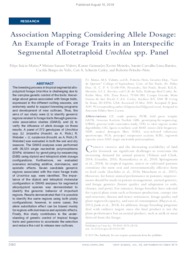Association Mapping Considering Allele Dosage: An Example of Forage Traits in an Interspecific Segmental Allotetraploid Urochloa spp.
Association Mapping Considering Allele Dosage: An Example of Forage Traits in an Interspecific Segmental Allotetraploid Urochloa spp.
Autoria: MATIAS, F. I.; VIDOTTI, M. S.; MEIRELES, K. G. X.; BARRIOS, S. C. L.; VALLE, C. B. do; CARLEY, C. A. S.; FRITSCHE-NETO, R.
Resumo: The breeding process in tropical segmental allopolyploid forage Urochloa is challenging due to the complex genetic control of the traits. Knowledge about genes associated with forage traits, expressed in the different cutting seasons, are extremely useful to support breeding programs and development of new cultivars. Thus, the aims of our study were (i) to identify genomic regions related to forage traits through genomewide association studies (GWAS), and (ii) to verify the influence of allele dosage on these results. A panel of 272 genotypes of Urochloa spp. [U. brizantha (Hoscht. ex A. Rich.) R. Webster ´ U. ruziziensis (Hoscht. ex A. Rich.) R. Webster] was evaluated in both the wet and dry seasons. The GWAS analyses were performed with 26,535 single nucleotide polymorphisms (SNPs) obtained by genotyping-by-sequencing (GBS) using diploid and tetraploid allele dosage configurations. Furthermore, we evaluated scenarios including additive, dominance, and epistatic effects. Seven candidate genomic regions associated with the main forage traits of Urochloa spp. were identified. The importance of the diploid and tetraploid molecular configuration in GWAS analyses for segmental allopolyploid species was demonstrated to identify the genomic behavior of important regions. Results demonstrated that it is possible to identify the same regions using both ploidy configurations; however, in some cases, the allele substitution effect can be biased mainly for regions with dominance and epistatic effects. Finally, this study contributes to the understanding of genetic control of tropical forage traits and genomics to accelerate the selection and reduce the cost to release new cultivars.
Ano de publicação: 2019
Tipo de publicação: Artigo de periódico
Unidade: Embrapa Gado de Corte
Palavras-chave: Animal performance, Animal proteins, Cattle feeding, Forage, Pastures, Tropical regions, Urochloa
Observações
1 - Por padrão são exibidas publicações dos últimos 20 anos. Para encontrar publicações mais antigas, configure o filtro ano de publicação, colocando o ano a partir do qual você deseja encontrar publicações. O filtro está na coluna da esquerda na busca acima.
2 - Para ler algumas publicações da Embrapa (apenas as que estão em formato ePub), é necessário ter, no celular ou computador, um desses softwares gratuitos. Sistemas Android: Google Play Livros; IOS: iBooks; Windows e Linux: software Calibre.
Acesse outras publicações
Acesse a Base de Dados da Pesquisa Agropecuária (BDPA) para consultar o acervo completo das bibliotecas da Embrapa.

